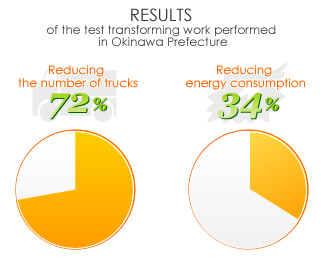The transforming work which was performed in Okinawa in September, 2005 shows that with the utilization of the HIT construction method, it successfully reduced the total energy consumption by 34% compared to the conventional method of construction. The current target for reduction in energy consumption is set at 47%.
EEBE (External Economic Benefit Evaluation) is a new concept which attempts to evaluate external economic benefits which have not been accounted for in the traditional profit & loss statement. EEBE is a method to evaluate in quantitative terms the extent of its contribution to the social environment and is able to evaluate in objective terms such technologies and businesses which are friendly to social environment and cause less environmental burdens.
In the case of the transforming work in Okinawa, the volume of the newly added asphalt mixture was smaller than that otherwise used by the conventional construction method. The reduction of asphalt mixtures has contributed to the saving of valuable resources such as petroleum and aggregates. Also, it has contributed to sustaining social environment through such as saving petroleum resources from the reduction of energy consumption, the reduction of gas emissions causing global warming and the elimination of wastes. The evaluated result with the EEBE method for the transforming work in Okinawa shows 5.39 million Japanese Yen as positive contribution. The evaluation has been done jointly with the Shin-Nihon Environment & Quality Research Institute and the Chuo-Aoyama Sustainability Certification Organization.










